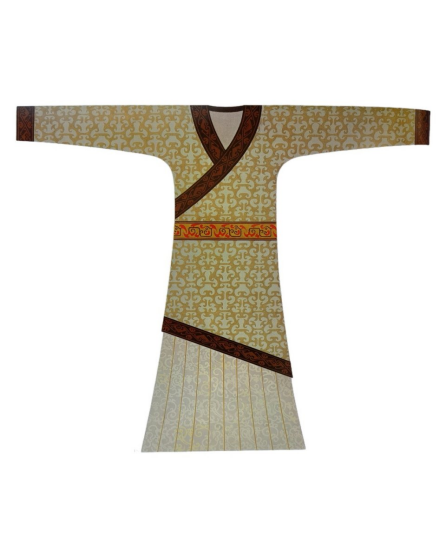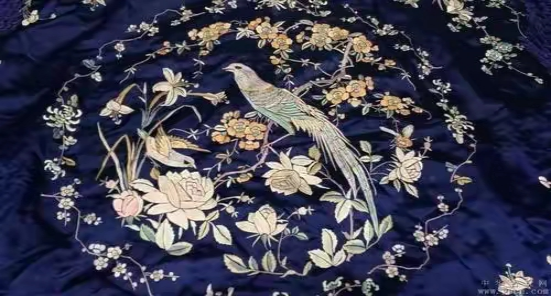
Traditional Chinese shoes have a history of thousands of years. They are not only highly practical but also embody rich cultural connotations. In the Hanfu system, shoes, together with clothing, require matching in terms of style, material and occasion.
In the history of shoe design, traditional Chinese shoes were mostly designed based on social hierarchy, occupation and ritual needs. For example, officials wore court boots, while common people wore cloth shoes. Therefore, to choose a pair of shoes suitable for Hanfu, it is very important to understand their practical background, design style and different styles. A suitable pair of Hanfu shoes is like adding an overhanging eave to a carefully built pavilion.
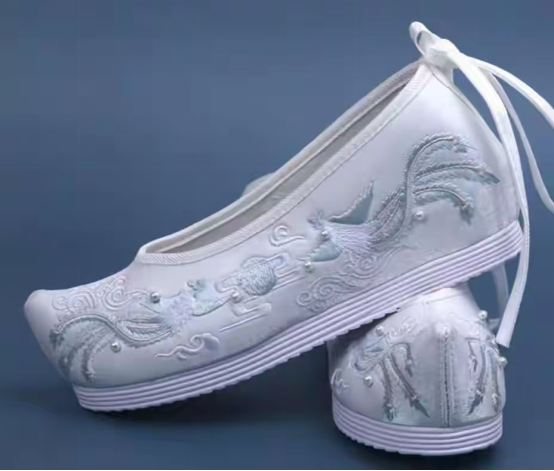
Women’s Hanfu Shoes
The selection of women’s Hanfu shoes is very diverse. Today’s shoes retain traditional elements while incorporating more modern aesthetics. Common types of female’s Hanfu shoes include embroidered shoes, curved-toe shoes, cloud-headed shoes, high-headed shoes, platform shoes, flat shoes, straw shoes, linen shoes and improved flat shoes.
With the addition of modern design elements, many brands have launched low-heeled or flat daily styles. For example, solid-color cloth shoes matching horse-face skirts, or lace-edged embroidered shoes matching ruqun (a type of Hanfu with a short jacket and a long skirt). Their colors also match the main tones of Hanfu.
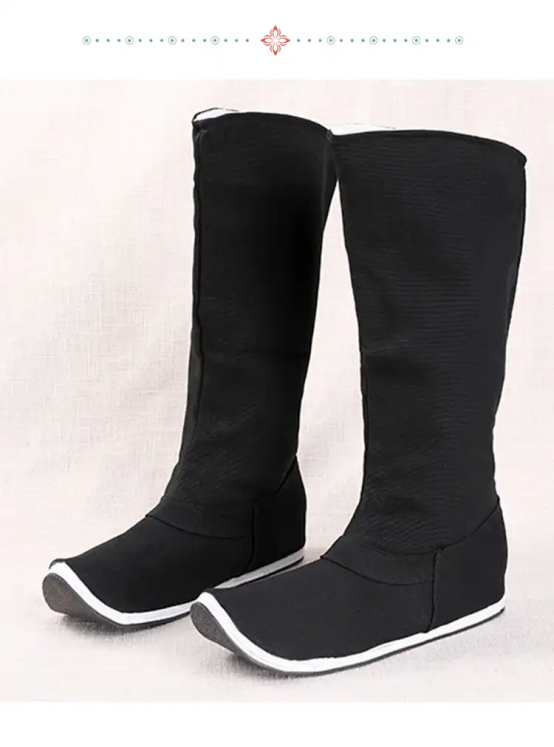
Men’s Hanfu Shoes
Traditional Men’s Hanfu shoes emphasize steadiness and grandeur in style. Common types include black boots, cloud-headed shoes, high-walled shoes, ancient xi (a type of traditional shoe), clogs, ordinary boots, cloth shoes and linen shoes.
Among them, black boots were originally worn by ancient officials. In modern times, however, black boots have more applicable scenarios and can be seen at weddings or celebrations. For daily wear, a pair of simple black or dark blue cloth shoes can meet most matching needs with Hanfu.
Nowadays, modern improved “male’s Hanfu shoes” made of leather are also very popular. They retain the traditional style but add non-slip soles, making them more practical.
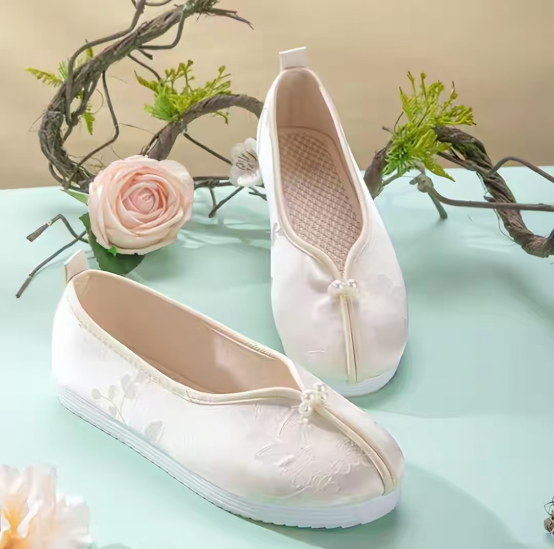
Development History of Hanfu Shoes
Traditional chinese footwear are a large family with many types. Men’s and women’s styles have their own characteristics, and they can be divided more carefully according to style and function. This rich classification has a profound historical origin.
The xi that appeared in the Pre-Qin period reflects the initial development of productivity and the initial formation of ritual systems in that era.
The popularity of upturned-toe shoes in the Han Dynasty not only met the practical needs of wide-sleeved and long-robed clothing but also integrated people’s pursuit of self-cultivation at that time.
The high-headed shoes and brocade boots in the Tang Dynasty reflected the strong national power of the Tang Dynasty and demonstrated its open and inclusive social atmosphere.
In the Song Dynasty, with the expansion of the literati class, a simple style of cloth shoes became very popular.
In the Ming and Qing Dynasties, the craftsmanship of curved-toe shoes reached its peak. The platform shoes of the Qing Dynasty also added more ethnic colors to Hanfu shoes.
Today, the development of Hanfu shoes has evolved into more styles that meet modern people’s aesthetic needs. Improved Hanfu shoes can also serve modern people’s lives again.
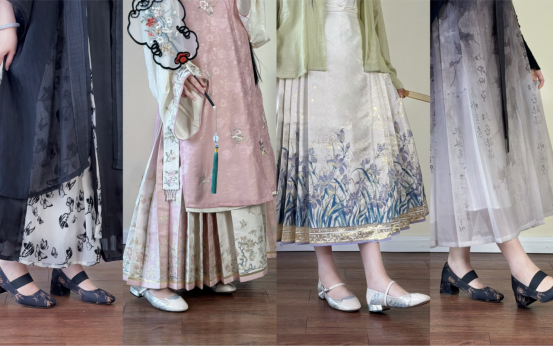
Matching Hanfu Shoes
When matching Hanfu shoes, we need to focus on the style of Hanfu, the occasion and personal comfort requirements.
If you wear formal Hanfu such as quju (a type of Hanfu with curved plackets) or xuanduan (a solemn Hanfu for formal occasions), it is advisable to choose shoes with embroidery or exquisite details. This can match the grandeur of formal occasions.
For daily wear, such as when wearing beizi (a loose outer jacket in Hanfu), Song-style pants or other casual Hanfu for outings, you can choose simple cloth shoes or canvas embroidered shoes.
The color of the shoes should also match the color of the Hanfu. Light-colored Hanfu matches light-colored shoes, and Hanfu with a rich style matches shoes with complex embroidery.
In addition, the season for wearing the shoes is also important. In summer, shoes should not only retain basic aesthetics but also be breathable. In winter, shoes should be lined with cotton and thickened for good warmth retention. However, no matter how you choose Hanfu shoes, remember that shoes should not overshadow the Hanfu itself. Instead, they should be a tool to enhance the overall charm.
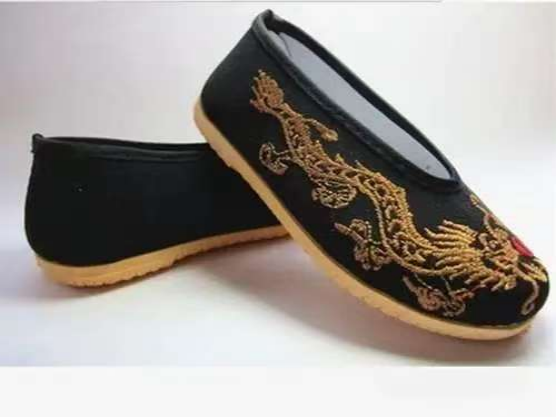
Applicable Scenarios for Hanfu Shoes
| Occasion | Type of Shoes |
| Weddings, sacrificial rituals, important ceremonies | Wear styles with high-quality materials and exquisite craftsmanship. For example, men can wear cloud-headed shoes or high-walled shoes; women can wear exquisitely embroidered curved-toe shoes or high-headed shoes to show solemn temperament. |
| Daily casual occasions (e.g., commuting, outings) | A pair of comfortable shoes is essential. Unisex cloth shoes and low-cut flat shoes are good choices. Match them with suitable Hanfu to create a unique clothing charm. |
| Cultural events with specific dynastic themes | Choose shoes that match the dynastic background and Hanfu style. For example, match Tang Dynasty-themed Hanfu with brocade boots or high-headed shoes; match Song Dynasty-themed Hanfu with simple and elegant cloth shoes. |
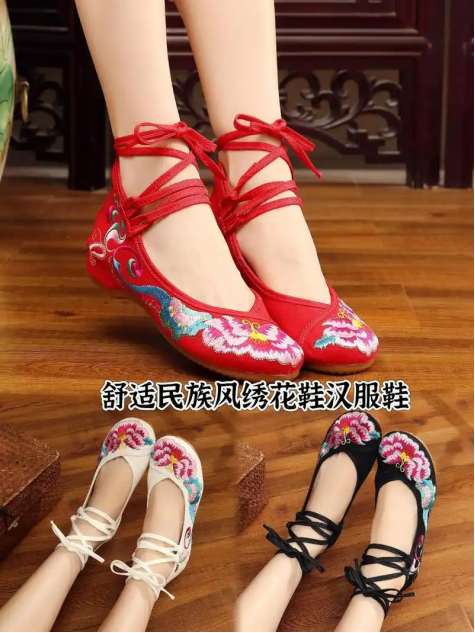
Are There Embroidered Hanfu Shoes?
Many people now wonder if there are embroidered styles of Hanfu shoes. The answer is yes. As mentioned earlier, embroidered styles are among the classic styles of Hanfu shoes.
Embroidery is a representative of China’s ancient traditional craftsmanship. It appears not only on shoes but also plays an important role in many clothing elements.
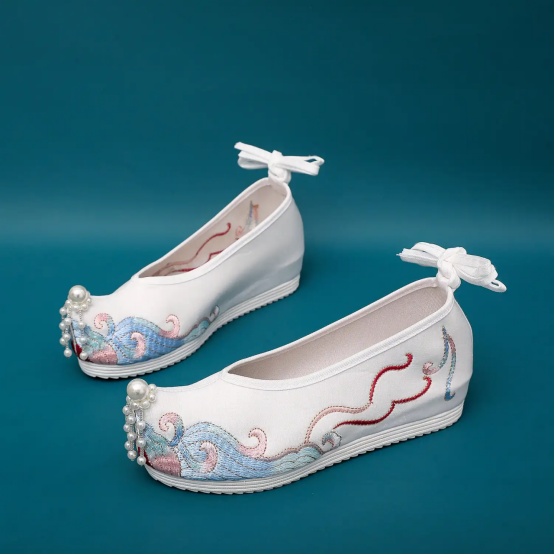
How to Choose Hanfu Shoes
Matching Hanfu shoes is important, and making the right choice is also something we cannot ignore. When choosing Hanfu shoes, we should balance aesthetics and practicality.
1. Confirm whether the style of the shoes matches the chosen Hanfu style.
2. Pay attention to the material of the shoes. Choose wear-resistant and breathable fabrics to suit long-term wear.
When trying on the shoes, make sure they fit well. Do a few large movements to check if the shoes can accompany you in different scenarios.
In general, the color and pattern of the shoes should match the specific Hanfu. Do not make a mismatch that spoils the overall look.
Hanfu shoes come in various styles and prices. If you are a beginner, it is recommended to start with basic styles at a moderate price to avoid mistakes.
Nowadays, when people wear Hanfu, they often overlook the importance of shoes, thinking that shoes don’t matter and they can just wear whatever is convenient. However, choosing the right Hanfu shoes adds the finishing touch to your overall Hanfu ensemble and only then can it truly embody the complete aesthetic value of Hanfu. Our Hanfu website allows you to experience the most direct and maximal sartorial beauty of Hanfu.



